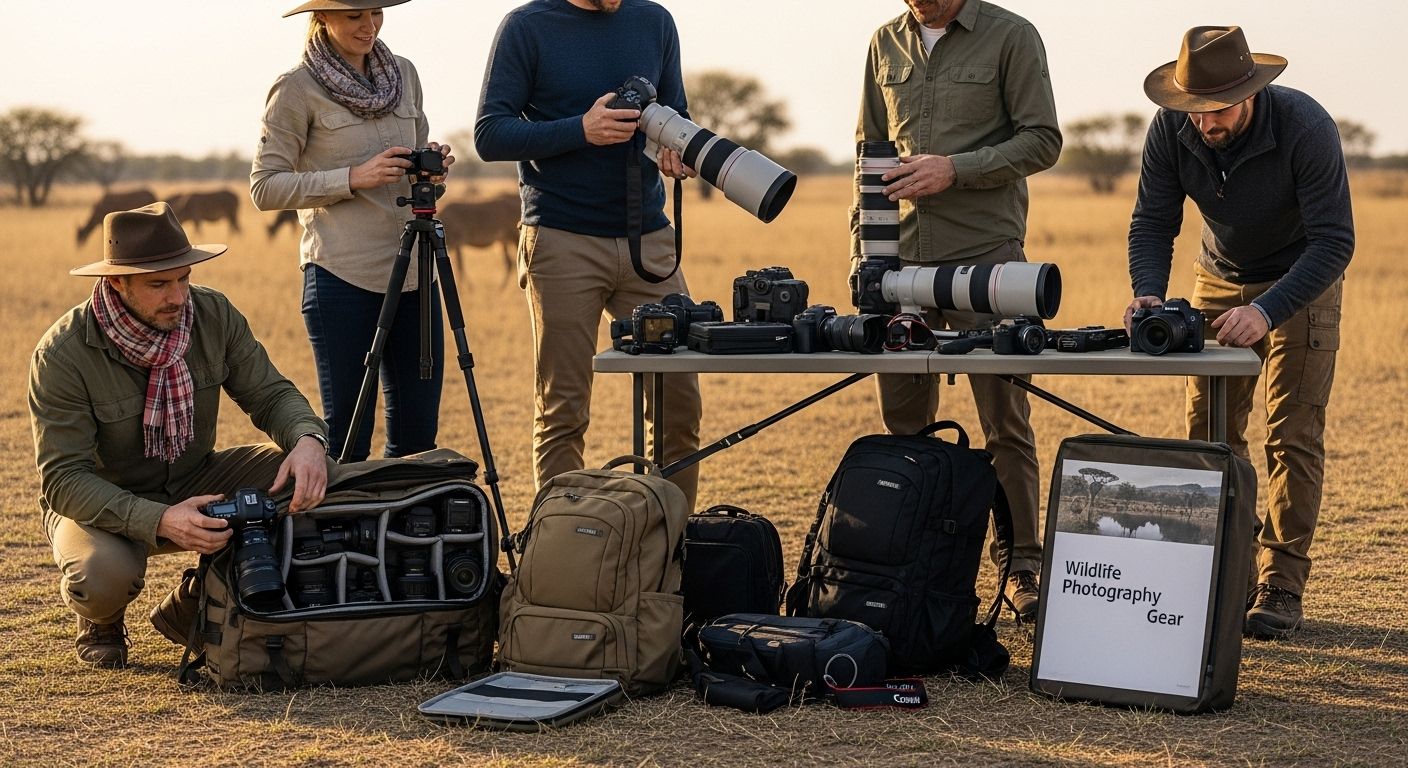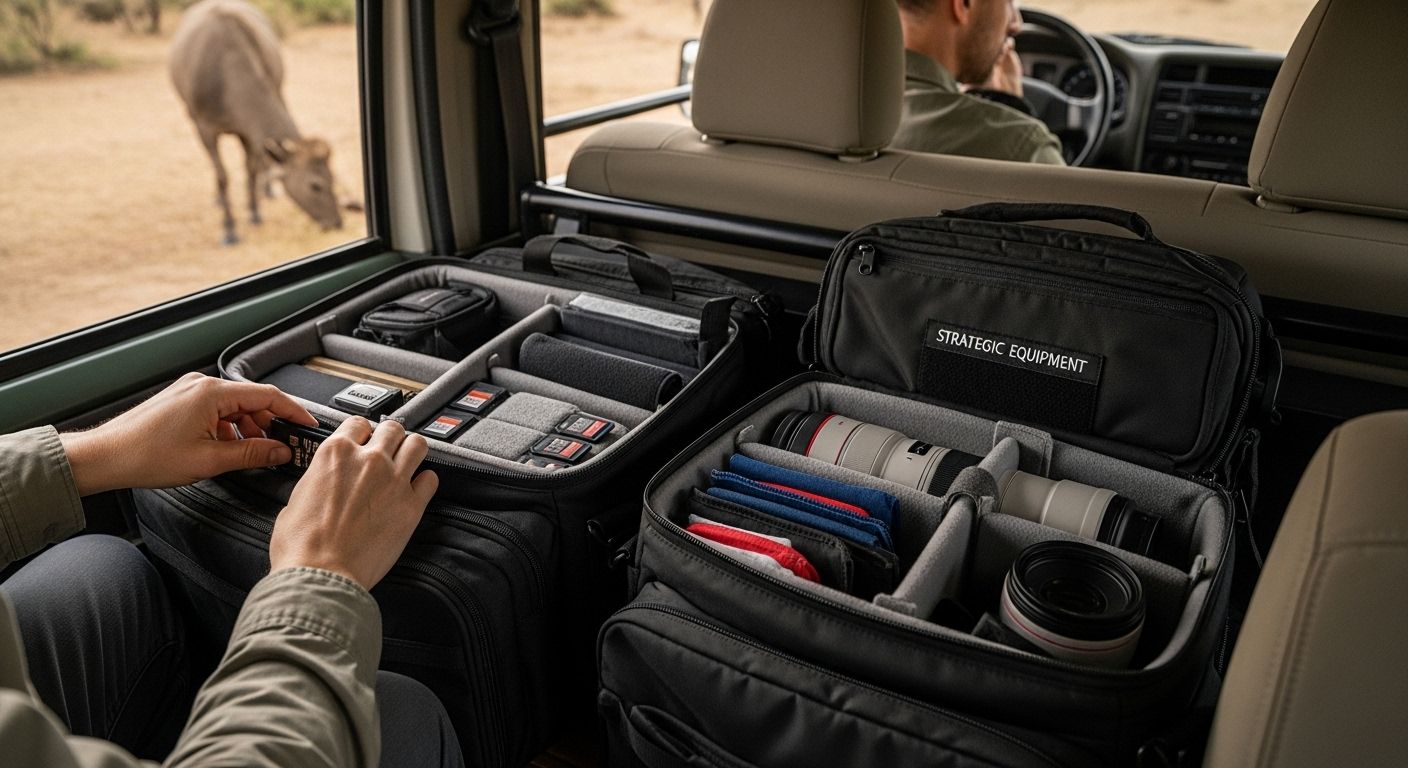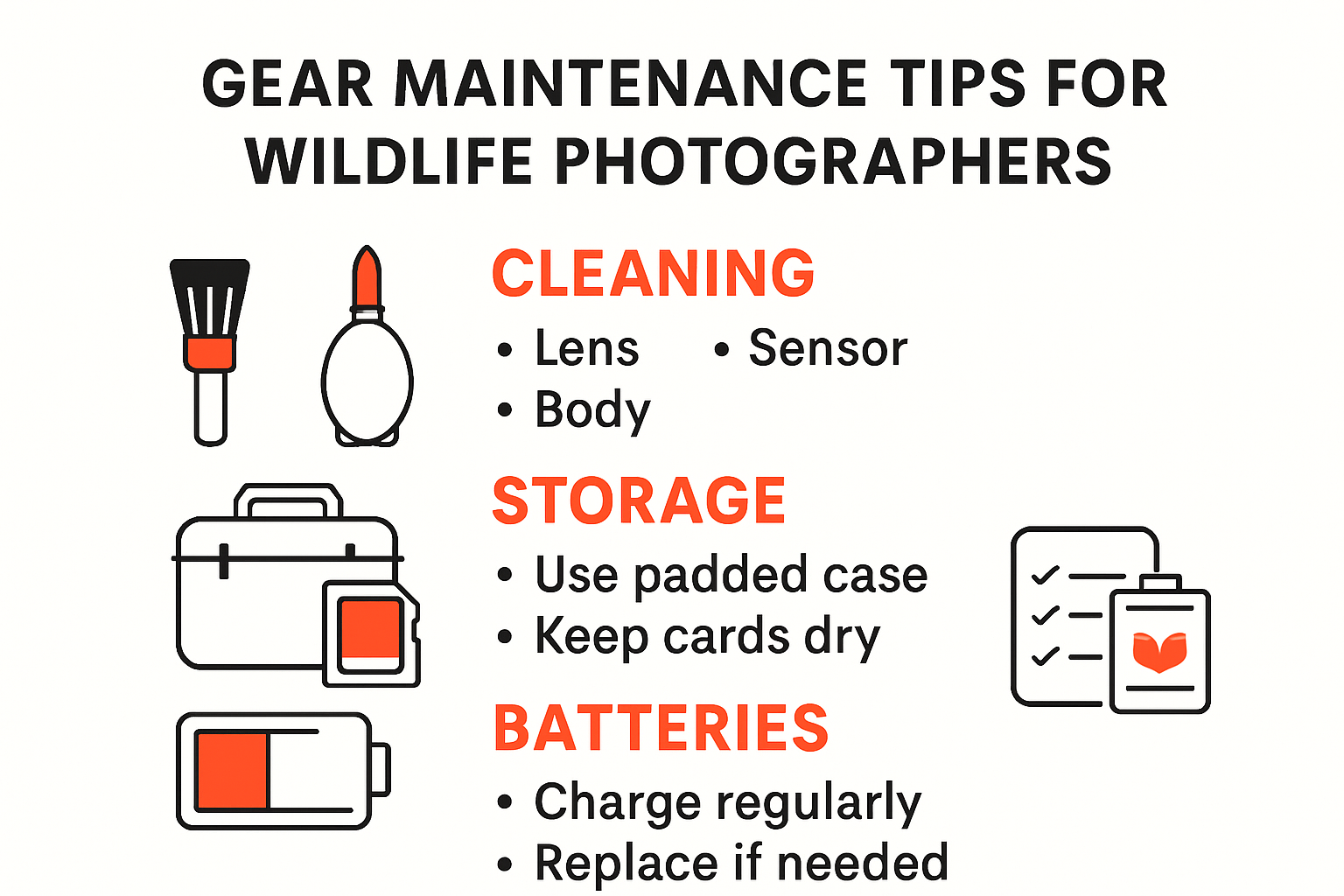Essential Wildlife Photography Gear for Every Traveller
Full Disclosure: Our AI Assistant Writes These!
While we're out in the bush tracking leopards, dodging elephants, and trying to get the perfect sunset shot, our trusty AI companion is back at camp, diligently crafting these blog posts. Don't worry though - it's been trained on years of real safari experiences and only occasionally suggests that tourists should pet the lions. (Please don't pet the lions. The AI was joking. We hope.)
The real reason? SEO loves fresh content, and we love fresh adventures. So while our AI handles the keywords and search rankings, we're out there finding the next hidden waterhole, secret viewpoint, or that one tree where the leopards always hang out. Win-win, really!
Essential Wildlife Photography Gear for Every Traveller

Wildlife photography calls for gear that can handle dust, humidity, and fast-moving animals. Many travellers assume it is all about having the latest camera with the highest megapixels. But the real difference comes down to choosing the right lens and packing smart, with telephoto lenses of 200mm to 600mm often making the shot possible without scaring off wildlife. Your backpack choices and how you protect your gear in the wild can actually shape your success much more than you might expect.
Table of Contents
- Choosing The Right Wildlife Photography Gear
- Must-Have Accessories For Different Adventures
- Packing Smart For Safaris And Overland Trips
- Tips To Protect And Maintain Your Gear
Quick Summary
| Takeaway | Explanation |
|---|---|
| Invest in a high-quality camera body | A reliable camera with rapid autofocus and weather-sealing is essential for capturing wildlife effectively in unpredictable environments. |
| Choose the right telephoto lens | Focal lengths between 200mm and 600mm are ideal for photographing distant wildlife without disturbing them; consider zoom for versatility. |
| Utilise essential protective gear | Robust protective gear, including waterproof covers and silica gel packets, is crucial for preserving camera equipment in extreme conditions. |
| Implement smart packing strategies | Organise your gear in lightweight, modular systems to protect equipment and maintain mobility during safaris or overland trips. |
| Regularly maintain and clean your gear | Consistent cleaning and professional servicing enhance the longevity and performance of your photography equipment, ensuring reliable results. |
Choosing the Right Wildlife Photography Gear
Photographing wildlife requires strategic gear selection that balances performance, durability, and adaptability in challenging environments. Professional photographers understand that success hinges not just on technical specifications but on understanding how different equipment responds to unpredictable outdoor conditions.
Camera Body Selection for Wildlife Photography
Selecting the appropriate camera body represents the foundation of exceptional wildlife photography gear. Modern wildlife photographers need cameras offering rapid autofocus, high burst rates, and exceptional low light performance. Research from National Geographic suggests professional wildlife photographers prioritize cameras with advanced tracking capabilities and weather-sealed bodies.
Digital single lens reflex (DSLR) and mirrorless cameras dominate the wildlife photography landscape. Key considerations include sensor size, frames per second, autofocus points, and image stabilization. Full frame sensors provide superior image quality and improved performance in challenging lighting conditions, while crop sensor cameras offer extended reach with telephoto lenses.
Lens Selection and Focal Length Considerations
Telephoto lenses represent the most critical component of wildlife photography gear. Wildlife Photographer’s Handbook recommends focal lengths between 200mm and 600mm for capturing distant subjects without disturbing natural habitats. Telephoto zoom lenses provide flexibility, allowing photographers to adjust composition quickly without changing equipment.
Professional wildlife photographers typically carry multiple lenses to address different shooting scenarios. A 100-400mm zoom lens offers versatility for medium distance subjects, while prime telephoto lenses like 500mm or 600mm provide exceptional detail and sharpness for distant wildlife interactions. Image stabilization becomes crucial when working with longer focal lengths to minimize camera shake.
To help you choose the right camera and lens setup for wildlife photography, here is a comparison of key features and ideal use cases for popular camera body and lens types discussed in the article:
| Gear Type | Key Features | Ideal Use Case |
|---|---|---|
| Full Frame DSLR | Superior image quality, better low-light, more dynamic range | Professional wildlife, difficult light |
| Crop Sensor DSLR | Extended lens reach, lighter, affordable | Travel, when extra focal length needed |
| Mirrorless Camera | Fast autofocus, compact size, silent shooting | Versatility, mobility, quick shots |
| 100-400mm Zoom Lens | Flexible focal range, good sharpness | Medium-distance, versatile subjects |
| 500mm Prime Lens | Exceptional detail, sharpness, fixed focal | Distant, specific wildlife species |
| 600mm Prime Lens | Maximum reach, outstanding sharpness, heavy | Birds, skittish or distant animals |
Essential Supplementary Wildlife Photography Equipment
Beyond cameras and lenses, successful wildlife photography requires strategic supplementary gear. Sturdy tripods with gimbal heads provide stability for heavy telephoto lenses, enabling smooth tracking of moving animals. Waterproof camera bags protect sensitive equipment from environmental challenges like dust, moisture, and sudden temperature changes.
Additional recommended gear includes extra batteries, multiple memory cards, lens cleaning equipment, and portable power banks. Professional photographers often invest in weather-resistant camera covers and lens hoods to protect against harsh environmental conditions. Our guide on safari photography gear offers comprehensive insights into selecting the right equipment for your wildlife photography adventures.
Choosing wildlife photography gear is an investment in capturing remarkable moments. Prioritize equipment that offers reliability, adaptability, and superior optical performance to transform your wildlife photography from ordinary snapshots to extraordinary visual narratives.
Must-Have Accessories for Different Adventures
Wildlife photography adventures demand more than just cameras and lenses. Professional photographers understand that specialized accessories can dramatically enhance image quality, protect equipment, and improve overall shooting experience across diverse environments.
Advanced Protective Gear for Extreme Conditions
Navigating challenging terrain requires robust protective accessories designed to shield sensitive photography equipment. Professional Wildlife Photography Association recommends investing in high-quality protective gear that can withstand extreme temperatures, dust, humidity, and unexpected environmental challenges.
Waterproof camera rain covers become essential in tropical and subtropical regions, preventing moisture damage during unexpected rainfall. Robust silica gel packets help manage humidity inside camera bags, protecting electronic components from potential condensation. Professional-grade camera backpacks with padded compartments and weather-resistant materials provide critical protection against physical impacts and environmental variations.
Specialized Mounting and Stabilization Accessories
Stabilization represents a crucial aspect of wildlife photography gear. Gimbal heads, which allow smooth pan and tilt movements, enable photographers to track moving wildlife with precision. National Geographic Photography Experts highlight that professional-grade tripods with carbon fiber construction offer an optimal balance between lightweight design and exceptional stability.
Additional stabilization accessories include monopods, bean bags for ground-level shooting, and specialized window mounts for vehicle-based wildlife photography. These accessories help photographers maintain image sharpness while minimizing physical strain during extended shooting sessions. Wireless remote triggers and intervalometers provide additional flexibility for capturing wildlife without disturbing natural habitats.
Essential Electronic and Power Management Accessories
Electronic accessories play a critical role in maintaining continuous photography workflow during extended adventures. Portable power banks with multiple charging ports ensure cameras, smartphones, and other electronic devices remain operational in remote locations. Multiple high-capacity batteries with quick-swap capabilities prevent missed photographic opportunities.
Memory card readers with robust data transfer capabilities and rugged external hard drives help photographers manage and backup image collections in challenging field conditions. Our comprehensive safari packing guide offers additional insights into managing electronic accessories during wildlife photography expeditions.
Choosing the right accessories transforms wildlife photography from a challenging endeavor into a seamless, enjoyable experience. Invest in quality gear that provides protection, stability, and reliable performance across diverse environments, ensuring you capture extraordinary moments with confidence and precision.
Packing Smart for Safaris and Overland Trips
Effective packing represents a critical strategy for wildlife photographers embarking on safari and overland adventures. The right approach to gear management can mean the difference between capturing extraordinary moments and missing critical photographic opportunities.
Strategic Equipment Protection and Weight Management
The U.S. Fish & Wildlife Service emphasizes the importance of careful gear selection and protection during wildlife expeditions. Professional photographers must balance comprehensive equipment needs with practical weight limitations, understanding that every additional kilogram impacts mobility and shooting flexibility.
Modular packing systems with padded, waterproof compartments provide optimal protection for sensitive photography equipment. Photographers should prioritize lightweight, multi-functional gear that offers maximum versatility. Specialized camera inserts that fit within standard backpacks allow photographers to maintain equipment security while preserving overall luggage flexibility. Lightweight, compact rain covers and dust protection accessories become essential for maintaining gear integrity across diverse environmental conditions.
Packing efficiently is crucial for wildlife photographers travelling on safari and overland trips. Here’s a checklist of essential packing strategies and recommendations outlined in the article:
| Packing Task | Recommendation / Action | Status |
|---|---|---|
| Use modular padded compartments | Protects equipment, optimises organisation | Yes |
| Prioritise lightweight gear | Enhances mobility, reduces fatigue | Yes |
| Include rain covers and dustproof accessories | Maintains gear integrity in harsh conditions | Yes |
| Use camera inserts in regular backpacks | Security and flexibility for travel | Yes |
| Carry multi-functional equipment | Reduces unnecessary weight and increases versatility | Yes |
| Prepare charging solutions/adapters | Ensures continuous power in various regions | Yes |
Environmental Adaptation and Gear Preparation
National Park Service wildlife experts recommend comprehensive preparation for varying environmental challenges. This includes selecting gear that can withstand temperature fluctuations, humidity variations, and potential physical impacts. Silica gel packets, robust camera bags with multiple compartments, and modular storage solutions help photographers maintain equipment performance in unpredictable conditions.
Additional protective strategies include using lens filters to shield optical elements, carrying multiple microfiber cleaning cloths, and investing in compact air blowers for removing dust and debris. Photographers should also consider portable charging solutions with multiple adapter configurations to ensure continuous power across different regional electrical standards.
Clothing and Personal Gear Considerations
Packing smart extends beyond photography equipment to include personal comfort and functionality. Our comprehensive safari packing guide provides detailed insights into selecting appropriate clothing and personal gear for wildlife photography expeditions.
Professional wildlife photographers recommend lightweight, moisture-wicking clothing in neutral colors that blend with natural environments. Quick-drying fabrics, convertible pants, and layerable clothing systems offer maximum adaptability across different climate zones. Essential personal accessories include high-SPF sunscreen, wide-brimmed hats, polarized sunglasses, and robust hiking boots with ankle support.
Successful safari and overland photography demands a holistic approach to packing. By carefully selecting versatile, protective gear and maintaining a strategic, weight-conscious approach, photographers can focus on capturing remarkable wildlife moments without being encumbered by logistical challenges. Preparation transforms potential obstacles into opportunities for extraordinary photographic experiences.

Tips to Protect and Maintain Your Gear
Maintaining wildlife photography equipment demands meticulous care and strategic preservation techniques. Professional photographers understand that proper gear maintenance directly impacts image quality, equipment longevity, and overall photographic performance across challenging environments.
Cleaning and Environmental Protection Strategies
The University of Nebraska–Lincoln’s wildlife management experts emphasize the critical importance of regular equipment cleaning and protection. Specialized cleaning protocols involve using soft, non-abrasive microfiber cloths to remove dust, dirt, and potential biological residues without scratching delicate optical surfaces.
Professional photographers recommend carrying dedicated lens cleaning kits with air blowers, microfiber cloths, and specialized cleaning solutions designed for optical equipment. Moisture-absorbing silica gel packets inside camera bags help prevent internal condensation and potential fungal growth in humid environments. Protective UV filters can shield lens elements from dust, moisture, and potential physical impacts during wildlife photography expeditions.
Storage and Transportation Best Practices
Professional Photography Association guidelines highlight the significance of proper equipment storage and transportation. Hard-shell, padded camera cases with customizable foam inserts provide optimal protection against physical impacts, temperature variations, and potential transportation damage. Photographers should invest in cases with robust water-resistant and dust-proof capabilities.
Additional storage recommendations include using lens caps and body caps when equipment is not in use, storing cameras and lenses in a cool, dry environment away from direct sunlight, and avoiding extreme temperature fluctuations. Rotating storage locations and periodically checking equipment for potential moisture or dust accumulation helps prevent long-term degradation of sensitive photographic gear.
Regular Maintenance and Professional Servicing
Routine equipment maintenance goes beyond basic cleaning and storage. Our comprehensive safari photography guide recommends periodic professional sensor cleaning, firmware updates, and comprehensive equipment inspections. Photographers should maintain detailed maintenance logs tracking equipment usage, cleaning intervals, and any potential performance issues.
Consider scheduling annual professional servicing with authorized equipment manufacturers or specialized camera repair centers. This proactive approach helps identify potential mechanical issues, calibrate autofocus systems, and ensure optimal equipment performance. Battery maintenance also plays a crucial role, with experts recommending complete discharge and recharge cycles every few months to maintain battery health and longevity.

Successful wildlife photography requires more than exceptional technical skills. By implementing comprehensive gear protection and maintenance strategies, photographers can ensure their equipment remains reliable, responsive, and capable of capturing extraordinary moments across diverse and challenging environments. Thoughtful care transforms photography gear from mere tools into long-lasting, dependable companions in wildlife exploration.
Frequently Asked Questions
What should I consider when selecting a camera body for wildlife photography?
When choosing a camera body for wildlife photography, prioritise rapid autofocus, a high burst rate, and excellent low-light performance. Look for features like advanced tracking capabilities and weather-sealed construction to handle unpredictable outdoor environments.
Why are telephoto lenses important in wildlife photography?
Telephoto lenses are critical in wildlife photography because they allow you to capture distant animals without disturbing their natural behaviour. A focal length between 200mm and 600mm is ideal for maintaining distance while still achieving sharp and detailed images.
What protective gear should I use for my photography equipment?
Invest in waterproof camera rain covers, robust camera bags with padding, and silica gel packets to manage humidity. These protective accessories are essential for ensuring your equipment remains safe from harsh environmental conditions, such as dust and moisture.
How can I effectively pack my photography gear for a safari?
Utilise modular packing systems with padded compartments to optimise organisation while protecting your gear. Prioritise lightweight, multifunctional equipment, and include rain covers and dust protection accessories to maintain the integrity of your gear during safari adventures.
Elevate Your Wildlife Photography Into a Real African Safari
You have read about the importance of rugged gear, smart packing, and the right camera for incredible wildlife photography. But the best equipment is only one part of the adventure. Without the right destination and expert planning, all your gear might never capture that breathtaking lion at sunrise or the gentle elephants crossing the savanna.
Step confidently from planning to action. Africa Awesome connects your technical preparation with experiences that truly matter. We offer tailored safari packages, local travel experts, and smooth booking for bucket-list locations such as Kruger, the Serengeti, and the Okavango Delta. Our home page lets you browse tours, get honest insights, and secure flexible bookings all on one platform.

Ready to put your wildlife photography skills to the test on Africa’s iconic landscapes? Book your next journey with Africa Awesome today to access exclusive itineraries, expert guidance, and unforgettable moments. Do not let your perfect gear stay in the bag. Discover Africa and capture the extraordinary now.